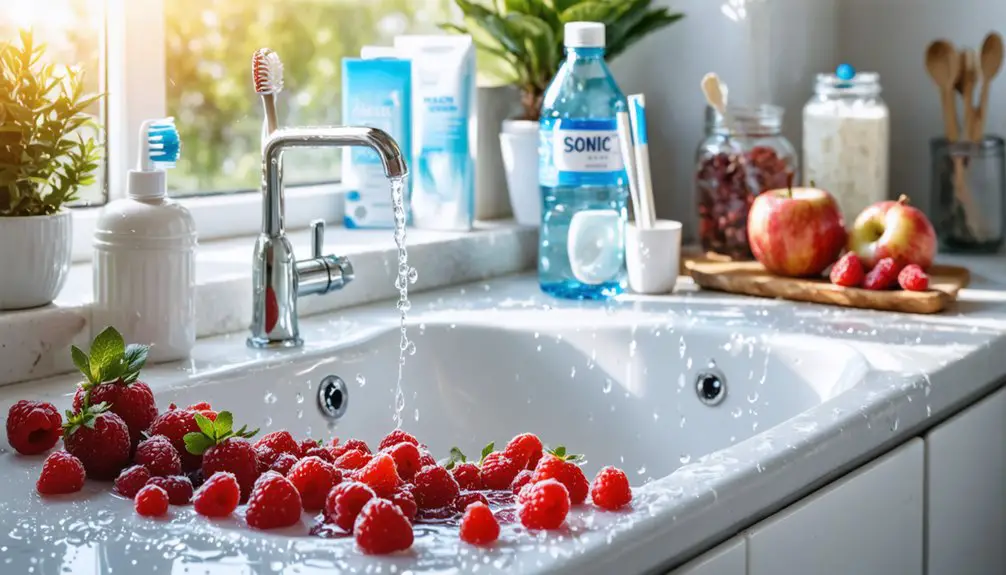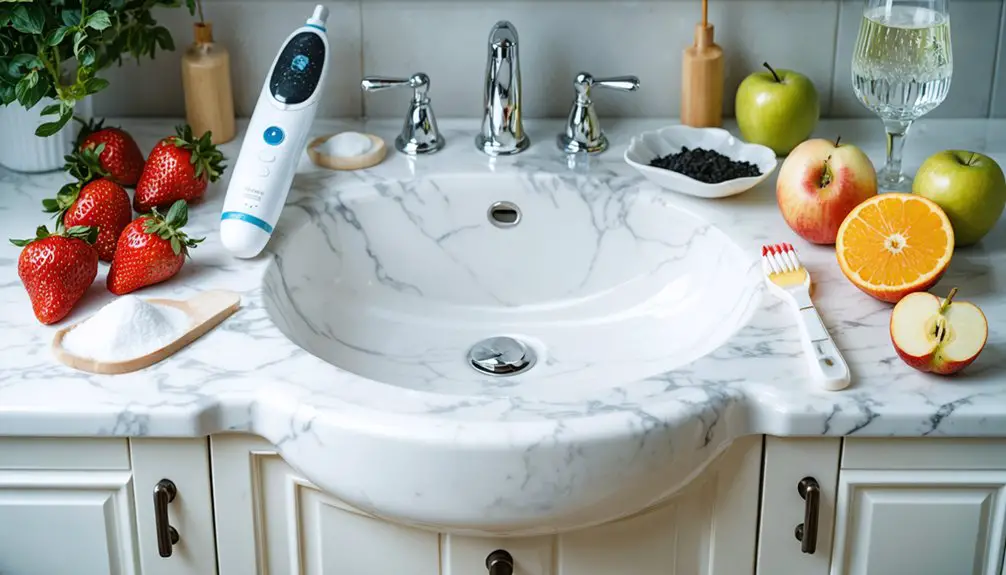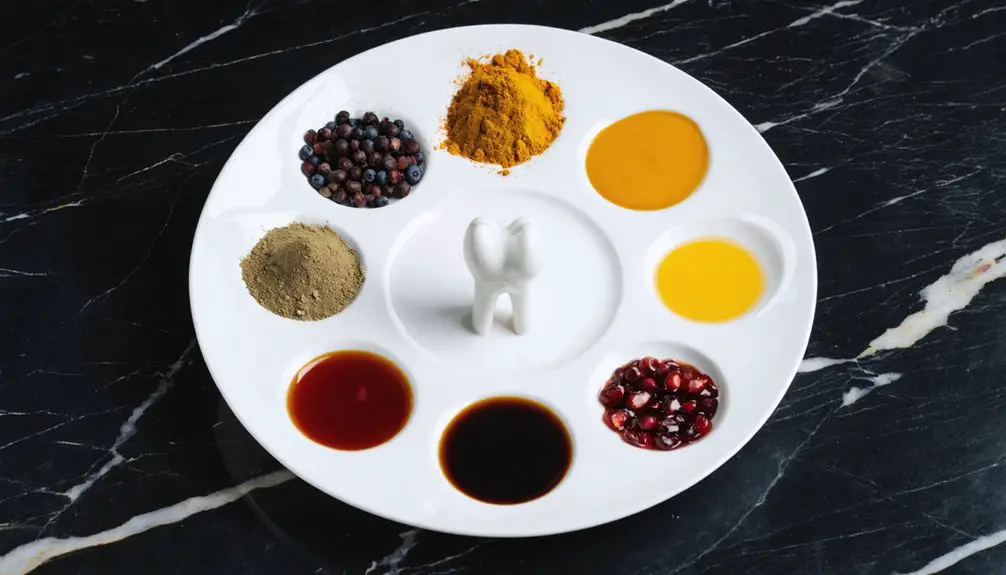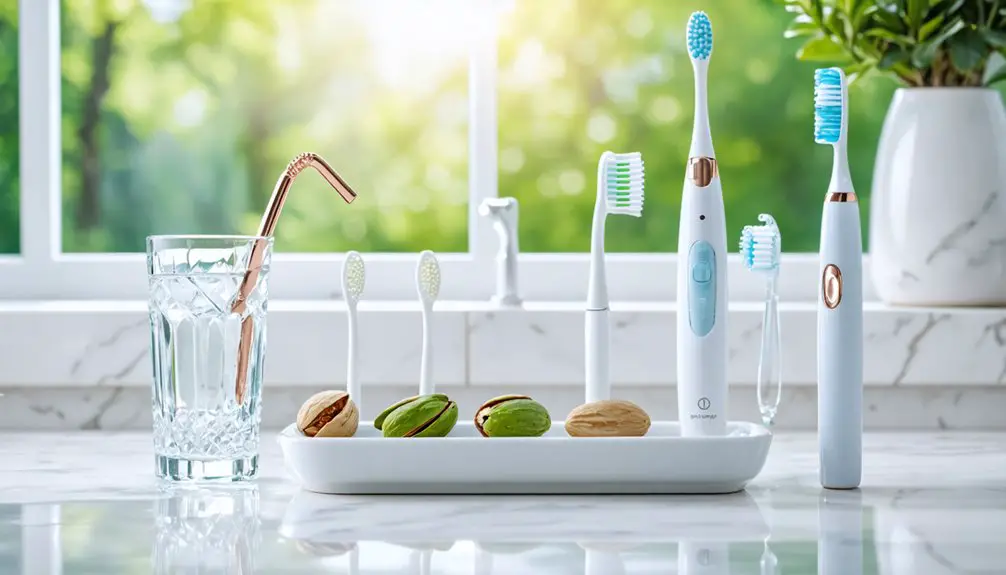To prevent raspberry teeth staining, you’ll need to combine smart eating techniques with proper oral care. Rinse your mouth immediately with water after consuming berries, wait 30 minutes before brushing, and use a straw when drinking berry smoothies. Pair raspberries with protective foods like cheese or crunchy vegetables, and maintain regular dental cleanings. Consider whitening toothpaste with hydrogen peroxide or baking soda for residual stains. These foundational steps open the door to even more advanced stain-fighting strategies.
Key Takeaways
- Rinse mouth vigorously with water immediately after eating raspberries to flush away pigments and dilute staining compounds.
- Pair raspberries with dairy products like cheese or milk, as casein protein forms a protective barrier against stains.
- Use a straw when consuming raspberry beverages to minimize contact between pigments and front teeth.
- Wait 30 minutes before brushing teeth after eating raspberries to protect enamel from acid erosion.
- Eat crunchy fruits and vegetables alongside raspberries, as they act as natural tooth scrubbers.
The Science Behind Raspberry Teeth Staining
When you consume raspberries, their highly pigmented compounds called chromogens interact with your tooth enamel through a complex biochemical process.
The chromogen adhesion occurs due to tannins, acidic polyphenols that enhance the binding of these pigments to your teeth’s surface. This process becomes more pronounced as the acidic environment created by raspberries leads to enamel erosion, creating microscopic rough patches where stains can easily develop.
Tannins in raspberries bind pigments to teeth, while their acids erode enamel and create tiny pockets that trap stains permanently.
Your tooth enamel becomes particularly vulnerable when exposed to the organic acids in raspberries, which soften its structure and increase porosity. Drinking water immediately after eating raspberries helps wash away these staining compounds before they can set. Good oral hygiene including twice daily brushing is essential for minimizing raspberry-induced stains.
The lipophilic molecules in your dental pellicle then capture these pigmented compounds, while bacterial biofilms can trap additional staining agents. This creates a perfect environment for persistent tooth discoloration that’s stronger than simple surface staining.
Immediate Rinse: Your First Line of Defense
Understanding the biochemical process of raspberry staining leads us to an effective preventive measure: immediate water rinsing. When you consume raspberries, you’ll want to rinse with plain water within minutes to flush away staining compounds before they adhere to your teeth.
The immediate rinse benefits are significant: it dilutes chromogens, neutralizes acids, and protects temporarily softened enamel. Sugar-free gum can also stimulate saliva production to help wash away stains.
For ideal results, you’ll need to swish a full glass of water vigorously around all mouth areas, including between teeth. Dark pigments and tannins in raspberries can permanently discolor tooth enamel if left untreated. Rinse timing is essential – don’t delay, as pigments can quickly penetrate enamel.
Consider complementing your rinse with neutralizing foods like cheese or crisp apples. While rinsing isn’t a replacement for brushing, it’s your first line of defense against staining until you can brush safely after 30 minutes.
Strategic Timing for Brushing After Raspberries
Despite the urge to brush immediately after eating raspberries, waiting 20-30 minutes is crucial to protect your tooth enamel from damage. During this critical brushing timing window, your saliva naturally neutralizes acids and helps remineralize softened enamel. Eating dairy products afterward can help balance pH levels while you wait.
While you wait, rinse your mouth thoroughly with water to dilute acids and reduce staining potential. You can also chew sugar-free gum to stimulate saliva production, accelerating the natural protective process. An electric toothbrush model can help ensure you don’t brush too hard when cleaning raspberry stains.
For peak enamel protection, use a soft-bristled toothbrush when you do brush, applying gentle pressure at a 45-degree angle. Remember to clean all surfaces thoroughly for two minutes, paying special attention to areas prone to staining. This strategic approach guarantees you’ll effectively remove raspberry residue while preserving your tooth enamel’s integrity.
Smart Snacking Techniques to Minimize Stains
Beyond proper brushing timing, smart snacking strategies play a key role in preventing raspberry-induced stains.
You’ll want to pair your raspberries with crunchy fruits and vegetables like apples, carrots, or celery, as these naturally scrub your teeth while stimulating saliva production. Adding dairy products like cheese helps neutralize acids and provides calcium for enamel protection. Regular dental check-ups are essential to monitor and prevent staining issues. Just as with tea and coffee, drinking water frequently while consuming raspberries helps rinse away staining compounds.
Consider your snack timing carefully by incorporating raspberries into main meals rather than eating them as isolated snacks.
Include raspberries during main meals instead of snacking on them separately to minimize staining potential throughout the day.
When you’re serving smoothies, use a straw to direct pigments away from front teeth. Take small bites and chew with your back teeth to minimize contact with visible enamel.
For fruit combinations, opt for less pigmented alternatives when possible, and avoid mixing raspberries with acidic or deeply colored foods that could enhance staining.
Protective Foods to Pair With Raspberries
You’ll find dairy products like cheese and milk provide excellent protection when consuming raspberries, as their calcium content and pH-raising properties help neutralize acids while preventing stain compounds from adhering to your teeth.
Adding crunchy vegetables like broccoli or cauliflower to your berry snack creates a natural cleaning action through their fibrous texture while stimulating protective saliva production.
The iron content in these green vegetables forms an additional defensive barrier on your tooth enamel, helping shield against acid erosion and staining from berry pigments.
Regular brushing and flossing after eating raspberries helps remove pigments before they can set into teeth.
Similar to how casein protein in 2% milk reduces staining in tea, pairing milk with raspberries can help minimize discoloration risks.
Dairy’s Natural Defense Shield
When enjoying raspberries, pairing them with dairy products creates a powerful defense shield against tooth staining. Dairy benefits include casein protein, which forms a protective barrier on your teeth, preventing raspberry pigments from adhering to the enamel surface.
You’ll maximize enamel protection by consuming milk, cheese, or yogurt alongside or immediately after your raspberries.
The calcium and phosphates in dairy strengthen your enamel while counteracting the fruit’s natural acids. You’ll find that hard cheeses are particularly effective, as they stimulate saliva production and provide a physical barrier against stains.
Additionally, yogurt’s probiotics help reduce harmful biofilms that trap staining agents. By incorporating these dairy options, you’re not only preventing discoloration but also supporting overall oral health through enhanced remineralization and acid neutralization.
Crunchy Greens Help Clean
Raw crunchy vegetables provide powerful natural defense against raspberry stains through their mechanical cleaning action. Their fiber benefits work to scrub your teeth while increasing saliva production, which helps neutralize acids and wash away staining pigments.
The crunchy textures of vegetables like broccoli, celery, and cauliflower act as natural toothbrushes, reaching areas where stains often accumulate.
- Iron-rich broccoli strengthens your enamel against decay and staining
- Fibrous greens stimulate saliva flow for natural mouth cleansing
- Raw vegetables’ abrasive texture helps polish teeth and remove plaque
- Alkaline minerals in greens neutralize acidic effects from raspberries
- Chewing crunchy vegetables dislodges pigments before they can set
These natural cleaners work best when eaten raw, immediately after consuming raspberries, making them an ideal protective pairing for your patients.
Proper Flossing Methods for Berry Stain Prevention
Proper flossing technique plays an essential role in preventing berry-induced tooth stains between dental surfaces.
Regular flossing with proper technique is crucial for preventing stubborn berry stains from discoloring the spaces between your teeth.
You’ll want to guide the floss gently between your teeth in a C-shape motion, ensuring it curves around each tooth and slides beneath the gumline. Use fresh sections of floss for each tooth to avoid redistributing pigments.
For ideal stain prevention, you should floss at least once daily, ideally before bedtime.
After consuming berries, wait 30 minutes before brushing due to acid-softened enamel, but you can floss immediately to remove surface pigments.
Choose waxed or smooth floss for tight contacts, or dental tape for wider gaps.
Combine your flossing routine with water rinsing after berry consumption and regular professional cleanings to maintain stain-free teeth.
Effective Oral Care Products for Berry Lovers
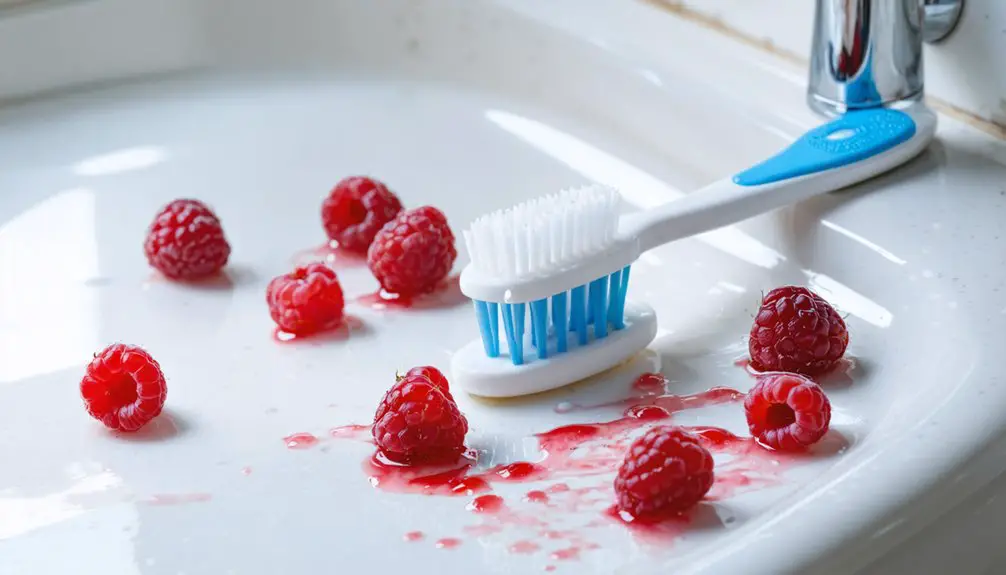
When combating berry stains, you’ll find premium whitening toothpastes containing hydrogen peroxide or baking soda particularly effective at removing surface discoloration.
You can enhance your stain-fighting routine by incorporating antibacterial mouthwashes formulated with polyphenols and hydrogen peroxide, which serve as natural bleaching agents.
Electric toothbrushes with specialized whitening modes provide consistent pressure and motion for ideal stain removal while protecting your enamel from excessive abrasion.
Premium Whitening Toothpaste Options
The science-backed selection of premium whitening toothpaste options can effectively combat the stubborn stains caused by berry consumption.
You’ll find that premium toothpaste benefits include advanced formulations with effective whitening ingredients like hydrogen peroxide and specialized abrasives that target berry-induced discoloration while protecting your enamel.
- Colgate Optic White Renewal offers clinical-grade 3% hydrogen peroxide, removing up to 10 years of yellowing in just four weeks.
- Crest 3D White’s protective shield technology prevents new stains while actively whitening existing ones.
- Arm & Hammer Advance White combines baking soda and peroxide for natural stain-lifting power.
- Fluoride-free options like Moon Stain Removal Gel provide gentle whitening for sensitive users.
- Natural alternatives such as Native Wild Mint offer daily protection against berry stains while maintaining enamel health.
Stain-Fighting Mouthwash Solutions
Selecting the right stain-fighting mouthwash becomes essential for berry enthusiasts who want to maintain their teeth’s natural whiteness.
Look for clear, dye-free formulations without cetylpyridinium chloride or chlorhexidine gluconate, as these mouthwash ingredients can contribute to surface staining.
For ideal stain prevention, choose fluoride-containing, alcohol-free options that strengthen enamel and combat tartar buildup.
Listerine Advanced White effectively removes plaque-causing bacteria while lifting existing stains.
Combine your mouthwash routine with thorough brushing and flossing to remove residual berry pigments.
You’ll achieve better results by using the mouthwash as directed and avoiding excessive use.
If you’re particularly concerned about staining, select products specifically formulated with anti-tartar properties and remineralizing agents that help maintain your enamel’s natural defense against discoloration.
Electric Toothbrush Stain Control
While mouthwash plays a key role in fighting stains, electric toothbrushes offer superior mechanical action for berry lovers concerned about tooth discoloration.
The advanced stain removal techniques combine sonic vibrations and rotating brush heads to effectively combat berry-induced staining. For ideal results, you’ll want to pair your electric toothbrush with baking soda-enhanced toothpaste, which safely breaks down stubborn pigments without damaging enamel.
- Sonic technology delivers up to 31,000 brush strokes per minute
- Built-in pressure sensors prevent excessive force while targeting stains
- RF-enabled models provide enhanced whitening capabilities
- Rotating heads guarantee uniform cleaning in hard-to-reach areas
- Consistent use helps prevent new stains from forming
These electric toothbrush features, when used regularly, create smoother tooth surfaces that resist future berry stain accumulation.
Drinking Techniques to Reduce Pigment Contact

Making strategic adjustments to your drinking technique can considerably reduce tooth staining from pigmented beverages and foods like raspberries.
You’ll want to use drinking straws when consuming berry-based drinks to minimize direct contact between pigments and your teeth. Remember to swallow quickly rather than letting the liquid linger in your mouth.
Maintain proper hydration benefits by drinking water immediately after consuming berries, and swish thoroughly to rinse away staining compounds.
Combine your berry consumption with dairy products, as casein proteins help neutralize pigments.
When drinking hot beverages, opt for cooler temperatures to prevent enamel pores from opening.
Don’t brush immediately after consuming acidic fruits – instead, wait 30 minutes while rinsing with water to protect your enamel from damage.
Professional Dental Solutions for Stubborn Stains
Professional dental treatments offer the most effective solutions for addressing stubborn tooth stains that resist home remedies. Your dentist can recommend various whitening techniques tailored to your specific needs, from in-office treatments that deliver immediate results to take-home professional kits with custom-fitted trays.
For severe discoloration, dental bonding or veneers provide long-lasting solutions when traditional whitening isn’t sufficient.
- In-office whitening treatments typically take one hour and use concentrated peroxide formulas.
- Custom take-home trays guarantee even application and reduced sensitivity.
- Professional cleanings remove built-up stains and prepare teeth for whitening.
- Dental bonding or veneers offer permanent solutions for intrinsic stains.
- Professional-grade maintenance products help preserve your results between treatments.
Natural Ways to Maintain White Teeth While Enjoying Berries
You’ll find protection against berry stains by consuming dairy products like cheese alongside your berries, as calcium-rich foods help shield tooth enamel from acidic compounds.
Following your berry intake with crunchy fruits and vegetables such as apples or celery will help scrub away potential staining agents while stimulating beneficial saliva production.
For immediate stain prevention after enjoying berries, you can swish water in your mouth or chew sugar-free gum to neutralize acids and wash away pigments before they settle into your teeth.
Dairy’s Protective Power
Three powerful compounds in dairy products – casein protein, calcium, and phosphate – work together to shield your teeth from berry stains while promoting dental health.
You’ll maximize dairy benefits by consuming milk, cheese, or yogurt before or after eating berries. These dairy products create a protective barrier on your enamel, neutralize staining agents, and stimulate saliva production to naturally cleanse your teeth.
- Casein protein forms a protective film that prevents pigments from adhering to enamel
- Calcium and phosphate strengthen tooth structure and reduce porosity
- Lactic acid fights bacteria that can trap berry stains
- Dairy proteins stimulate saliva flow to wash away pigments
- The combination of minerals and proteins provides ideal enamel protection against discoloration
Natural Teeth-Cleansing Foods
While enjoying your favorite berries, incorporating natural teeth-cleansing foods into your diet can effectively combat staining and maintain whiter teeth.
The fiber benefits of crunchy produce like apples, carrots, and celery work as natural abrasives to dislodge surface stains and plaque while you eat.
These foods also promote saliva stimulation, your mouth’s natural defense system against staining. Increased saliva production helps neutralize acids and wash away pigments that could otherwise discolor your teeth.
Combine berries with foods rich in malic acid, such as strawberries and apples, or eat them alongside broccoli and cauliflower, which mechanically polish your teeth’s surface.
For ideal protection, consume these cleansing foods during or immediately after enjoying staining-prone berries.
Quick Post-Berry Remedies
Despite berries’ potential to stain teeth, several immediate post-consumption remedies can effectively minimize discoloration risks.
Adopting smart berry consumption habits and following proven stain prevention tips can help maintain your teeth’s natural whiteness while enjoying these nutritious fruits.
- Rinse your mouth thoroughly with water immediately after eating berries to wash away pigments before they settle.
- Wait at least 30 minutes before brushing to protect your enamel from damage when it’s temporarily softened.
- Pair your berries with dairy products like cheese or milk to neutralize acids and create protective barriers.
- Use a straw when drinking berry smoothies or juices to minimize direct contact with your front teeth.
- Apply gentle whitening methods like occasional baking soda paste treatments to address any residual staining.
Frequently Asked Questions
Can Raspberry Stains Permanently Damage Tooth Enamel?
No, raspberry stains won’t permanently damage your tooth enamel, though they can cause temporary discoloration. You’ll maintain healthy enamel through proper stain prevention like brushing, rinsing, and regular dental cleanings.
Do Frozen Raspberries Stain Teeth Less Than Fresh Ones?
Like twin crimson drops, frozen versus fresh raspberries have equal staining power. You’ll face the same stain removal challenges since freezing preserves the chromogens and tannins that discolor your teeth.
How Long Do Raspberry Teeth Stains Typically Last?
You’ll notice raspberry stains fade within hours to a few days, depending on your teeth whitening routine and stain prevention habits. Proper brushing and rinsing after eating can greatly reduce staining duration.
Can Whitening Strips Remove Raspberry Stains More Effectively Than Regular Toothpaste?
Like a deep ocean wave clearing debris from shore, whitening strips penetrate your enamel more effectively than regular toothpaste. You’ll notice better whitening effectiveness since strips contain stronger peroxide for superior dental hygiene.
Are Some People’s Teeth Naturally More Resistant to Raspberry Staining?
Yes, your natural resistance to raspberry stains depends on genetic factors that determine your enamel thickness, mineral density, and saliva composition, which all affect how easily pigments stick to teeth.
References
- https://www.drsamcan.com/post/common-teeth-staining-culprits-and-how-to-prevent-them.html
- https://spencerdds.com/blog/berries-what-to-know-about-tooth-staining/
- https://newarkdentalohio.com/foods-and-drinks-that-can-stain-your-teeth-and-what-to-do-about-it/
- https://www.kidsdentalonline.com/foods-stain-teeth/
- https://www.deltadentalar.com/resources/blog/delta-dental/2024/12/09/berry-beneficial-can-tasty-treats-tint-your-teeth
- https://pmc.ncbi.nlm.nih.gov/articles/PMC9683888/
- https://www.nature.com/articles/s41598-023-43201-y
- https://ijcrt.org/papers/IJCRT2501548.pdf
- https://www.azfd.com/blog/top-foods-whiten-teeth-prevent-staining/
- https://bluetoothdental.com.au/blog/teeth-staining/
